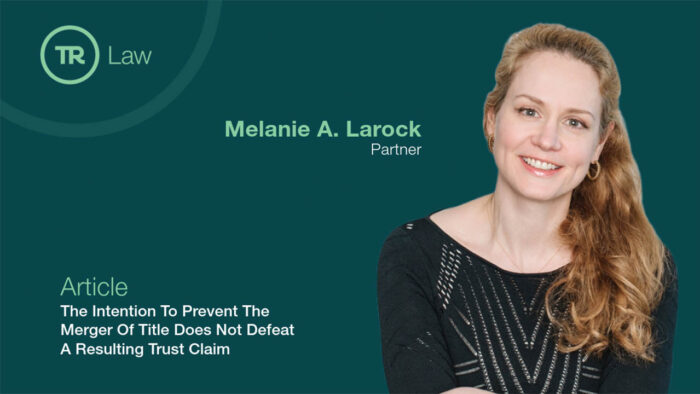Use and Abuse of Technology at Pre-Trial and Trial
Author(s): L. Craig Brown, Darcy R. Merkur
September 8, 2011
This paper is primarily directed at younger lawyers without significant trial experience who, by virtue of their facility with technology, are perhaps best equipped to use it creatively in the litigation process. The headings below present a wide range of starting points with practical tips based on our actual experience, at pre-trial and in the court room, with the magical array of technologies which are available to the modern trial advocate. We have not attempted to cover all available technologies, but we hope this primer will provide a useful foundation for the introduction of these aids into your practice.
1. Damage Assessments
Personal injury litigation is really all about the numbers.
All too often, pre-trial judges arrive at a settlement perspective while accidentally neglecting to consider all of the heads of damages claimed or while miscalculating significant items like pre-judgment interest or present value multipliers.
Counsel should come prepared at a pre-trial to correct mathematic errors by a judge or by opposing counsel. The easiest way to do so is to have a computer program ready to run alternate scenarios.
Despite appreciating the importance of the damage assessment to a successful resolution, plaintiff’s counsel often does not effectively present their damage assessment.
Plaintiff’s counsel will commonly leave it to the end of their lengthy pre-trial memo to try to summarize their damage assessment. Despite describing this part of their pre-trial memo as a summary or concluding section, the assessment often spans a number of pages and does not visually stand out in any way from the rest of the comprehensive memo.
These old-school assessments often approximate pre-judgment interest (by guessing the number of months, etc.) or round off present value multipliers because only annual rates are available on the actuarial tables that are readily available.
Practically speaking, an assessment that spans a number of pages is unlikely to be given proper attention by the reader and may not be thoroughly absorbed.
To be effective, a damage assessment should be:
- Accurate – a damage assessment must properly calculate issues like pre-judgment interest, discount rates, life expectancies and must properly apply contributory negligence reductions. Mistakes are regularly made calculating and applying these factors, especially when trying to alter assumptions and recalculate assessments.
- Concise – a damage assessment must be summarized on one page. Too often lengthy assessment summaries neglect to calculate the grand total of the claims being advanced. Because insurance companies approach personal injury litigation using a risk management approach, it is vital that opposing counsel and their client appreciate the true magnitude of the claim being advanced.
- Understandable – assumptions made about issues like income earning capacity, retirement age and contributory negligence must be clearly identified.
- Flexible – a damage assessment must be capable of being amended during the course of a pre-trial to address compromises made. Counsel should be able to instantaneously distribute amended damage assessments during the course of a pre-trial that still meet all of the criteria above.
These objectives can all be realized using sophisticated Excel based assessment programs. An Excel based program can be developed by any personal injury lawyer with some degree of experience in Excel.
Alternatively, the Ontario Personal Injury Damages Calculator, sold by Carswell
(developed by the co-presenter and co-author of this presentation, Darcy Merkur of Thomson Rogers), is available for an annual fee of under $200.00. Because it has been developed by an Ontario personal injury lawyer, the Ontario Personal
Injury Damages Calculator knows about all the statutory deductibles, the Ontario discount rates, pre-judgment interest rates, etc. and it pulls all of the information into a one-page damage assessment.
By circulating an effective damage assessment with your pre-trial material or at a pre-trial, a judge is more likely to address all of the heads of damages claimed and is more likely to accurately calculate his/her own assessment (for example, by being able to see and apply the accurate pre-judgment interest rate and by seeing the various assumptions used).
Furthermore, by attending at a pre-trial with the software ready to go, you can instantly calculate present values and pre-judgment interest, etc., along with contributory negligence impacts and can make sure that the totals being advanced by the judge or by opposing counsel are accurate.
It is also recommended that counsel attend a pre-trial with a portable printer so that any new assessments and scenarios can be accurately documented and circulated.
At trial, the principles associated with an effective damage assessment can be used when it comes to advancing future care costs. A one-page summary of all future care costs can be attached to the jury questions to allow the jury to weigh in and decide each future care item. By asking a jury to review each future care item rather than approach it as a lump sum, jurors are more likely to envision the plaintiff’s future and give due regard to their comprehensive medical needs.
A sample damage assessment is attached as Appendix “A”.
2. PowerPoint – Openings and Closings
Our experience in the past decade is that PowerPoint openings are very helpful in jury trials, but less so in trials before judges sitting alone.
A recent example of a jury opening PowerPoint presentation can be viewed on the Thomson Rogers’ website under either Darcy Merkur’s profile entitled “Geoffrey B v. Mechanical Company, et al”. In that PowerPoint, we adopt what has become our standard format of laying out the basic facts in bullets (9 slides in total), followed by a slide setting out the 4 main issues in the lawsuit – in this case:
The Issues
- Who is responsible for Geoffrey’s accident?
- How is Geoffrey different than before his accident?
- Why can’t Geoffrey return to work?
- What help does Geoffrey need in his daily life?
The remainder of the PowerPoint focuses on these issues and tries to anticipate evidence that will be called in relation to each of them.
In the PowerPoint, we try to highlight and focus on actual photographs, transcript excerpts or documents that will clearly be introduced as evidence in the trial, rather than narrative or bullet points which may detract from the oral presentation being made to the jury at the same time.
In a superb little handbook by John Miers entitled “Hit Me Again!…I Can Still Hear Him! (the Secrets of Superb Public Speaking)”, Miers warns against the overuse of PowerPoint slides. He points out that people cannot read and listen at the same time and that, if your PowerPoint slide contains extensive narrative or lengthy bullet points, the jury is unlikely to be listening to you as you speak to them. He goes on to point out that charts and diagrams should be simple and the viewer should be permitted time to absorb the information on the screen.
Miers makes a number of recommendations for the use of PowerPoint which we have tried to incorporate into our presentations, and which not only make sense but make the presentations more effective. His book is available at the Ben McNally Book Store on Bay Street just south of Richmond Street and is well worth buying.
Some of the advantages of doing a PowerPoint opening include:
- Opportunity to familiarize the jury with key photographs, documents or drawings at the opening of the trial.
- The opportunity to emphasize the organization of your case in a format that you can return to in your closing.
- If used properly, the slides will permit you to organize complex information in a compact, digestible form.
The key point to remember when using a PowerPoint presentation with a jury is not to have your oral presentation compete with the visual presentation on the screen. Proper introduction for the display of photographs, documents or drawings will ensure that the jury is able to absorb and interpret the information being presented to them rather than being confused by it.
Closings are somewhat different in that you have available to you a vast number of documents and other evidence that have been made exhibits in the trial, as well as the possibility of using excerpts from real time transcripts of the evidence that has been given by witnesses at trial. The challenge with a closing is to keep its length under control and not to try to review every document and exhibit filed during the trial.
Happily, the temptation to use narrative in a closing PowerPoint is much less because of the wealth of illustrative material available to you.
It can be useful to highlight sections of key documents or excerpts from transcripts to emphasize critical information helpful to your case. It is also important to have a carefully scripted oral narrative which uses the PowerPoint slides as collateral or illustrative rather than narrative.
It is much easier to pull together your closing PowerPoint if, during the trial, you have been keeping electronic copies of exhibits and ordering transcripts of critical evidence.
3. Judicial Involvement By E-mail During Trial
Historically there was little communication between the judge and trial counseloutside of the court room.
E-mail has changed everything. Now, during the course of a trial, counsel is often asked and encouraged to communicate with counsel and the judge by e-mail after regular court hours. Most judges will welcome this form of communication, especially in a jury case, although obviously counsel should check with the judge before doing so.
When dealing with a jury case, counsel should consider using e-mail dialogues between counsel and the judge to, where appropriate:
- Develop an agenda of items to be addressed without the jury.
- To address scheduling issues.
- To circulate case law that will be referenced.
- To exchange written submissions.
- To vet jury charges.
- To reviewed draft jury questions.
- To deal with motions.
The ability to use e-mail to effectively communicate with the judge and counsel during a trial falls apart though if one counsel refuses to be electronically accessible.
4. ELMO and Other Projection-Type Products
For the past 10 years, we have used ELMO’s visual presenter in every trial. It is the ‘Swiss Army knife’ in your electronic tool kit – it simply does a wide range of useful things.
Essentially, the ELMO is an electronic projector of great versatility. It will project books, photographs, documents, 3-dimensional objects and transcripts onto a large screen with no advance preparation necessary. It can zoom in on key documents or photographs as well.
The ELMO can also be a back-up device for other electronic projection systems which, notoriously, fail at critical times. For example, if you have a printed copy of your opening PowerPoint and for some reason your digital projector is not speaking with your computer, you can put the printed copy of each slide on the
ELMO (with a bit of assistance) and the show goes on.
For the past 4 years, we have been using the ELMO P30 visual presenter. It has been replaced by the P30 HD which apparently produces a much higher resolution image but is otherwise essentially the same.
In a pinch, you can use the ELMO to take digital photographs of documents and other objects which are then stored on the ELMO’s memory chip. They can then be transferred to a computer for other uses. The process is equally useful in reverse. You can load documents on a memory chip, insert it in the ELMO and run a very simple and robust digital slide show using the ELMO.
One of the disadvantages of having an ELMO at trial is that the defence will inevitably want to use it. We have always agreed and the fact is that they will not use it as effectively as you do, which the jury will not fail to notice.
On a recent trial, the jury asked to use the ELMO in the jury room during their deliberations. That is surely proof of its effectiveness and utility.
Some court rooms are wired to permit easy use of digital projectors and ELMOs.
The new court house in Whitby is a good example of a state-of-the-art facility.
Most of the older court houses present challenges – particularly in situating the screen so that everyone in the court room can see it. You will need to be creative in the positioning of the screen and the ELMO, and if the logistics present too great a problem, you may need to ask the judge to change the venue to a larger court room. Some court houses have built-in screens (Whitby for example), but for others, you should not rely on a portable screen supplied by the court house. Your own will likely be in better shape and you should bring one.
5. Real Time Transcripts
There is no use getting a witness to say something important if it is not remembered accurately.
The only effective means to prove what a witness says at trial is to have access to real time transcripts.
Real time transcripts are transcripts that are available instantaneously in draft form and in certified form usually within hours after the completion of a trial day.
Before commencing a complex trial, steps should be taken to ensure a real time reporter has been assigned to handle the trial. If, as is often the case, the court reporter assigned is not capable of providing real time transcripts, you should have them replaced by someone who can, even if it means making a substantial investment to get the right reporter there.
If replacing the court reporter proves difficult, ask the judge to facilitate the replacement. Most judges will help getting the court reporter replaced, as judges typically love being able to have access to real time transcripts rather than having to rely on their notes.
With a real time court reporter, counsel may request transcripts at the end of each day or when a witness leaves the stand. The transcripts are vital for use in cross-examinations and/or in closing submissions.
Real time transcripts are expensive but, in any significant case, the investment is justified. All parties usually end up supporting the initiative given that, if one counsel insists on having real time transcripts, the others must have them too to have any chance of responding effectively.
The common approach is to have each party share equally in the cost of having the real time court reporter in attendance, when necessary (this isn’t always necessary as some official court reporters are also capable of real time reporting). Then, the party ordering the transcripts pays for them, and provides the judge with a courtesy copy.
6. Accident Reconstruction Animations
The traditional term ‘animation’ has been replaced with the term ‘scientific visualization’ which sounds less like something produced by the Disney company. Issues relating to the admissibility of ‘scientific visualizations’ are long settled. For a comprehensive treatment of the law on this issue, please see the presentation by Michael Bennett published by Osgoode Professional Development in April 2009. A relatively recent ruling by the trial judge in Greer v.
Kurtz [2008] O.J. 2925 provides a comprehensive review of the applicable law.
In that case, a ‘visualization’ of the crash was admitted as having met the evidentiary safeguards set out in Owens v. Graudell [1994] O.J. 496, but a ‘visualization’ of potential avoidance maneuvers was rejected as conjectural and of no assistance to the court.
The more practical problem is how to project the visualization so that it can be seen by everyone in the court room and so that the engineer explaining it can do so in a compelling and memorable manner. Our experience confirms John Miers’ advice that a visual aid should be carefully explained in advance by the narrator and then shown without comment so that the jury is not distracted from what it is seeing by the speaker. It can be useful to have a series of ‘stills’ created so that a stop-action presentation can also be done to permit the speaker (engineer) to comment in detail on certain aspects of the reconstruction.
After the scientific visualization has been made an exhibit, it is important to ensure that it goes to the jury room in a form that is easily accessible by the jury during its deliberations. A computer with the visualization loaded into memory is a simple and robust way of doing this.
7. Electronic Transcripts and Documents
It is a challenge to instantly find a key excerpt from a print version of a discovery transcript. Do not be caught sifting through a print version of a transcript looking for references when you can search hundreds of pages instantly on your laptop through electronic transcripts.
Many litigation software programs allow for the easy upload and searching of transcripts, but at a minimum, counsel should have electronic discovery transcripts ready to be electronically searched while in the court room.
With respect to documents, key documents should be scanned using optical character recognition (OCR) technology, available on most modern photocopiers and scanners. By doing so, documents are put into a searchable electronic format. While handwritten notes may not be adequately searchable using OCR technology (although the latest OCR readers can read most legible handwriting), typed hospital records, medical reports, engineering reports, etc. will be completely searchable if they are scanned in properly.
Having documents scanned into a computer properly will, with or without supporting litigation software, allow counsel to locate key excerpts from documents in a flash.
8. Day-In-The-Life Videos
Much of the commentary about scientific visualizations also applies to day-in-the-life videos. The basic test of admissibility was set out by the Supreme Court of
Canada in Draper v. Jacklyn (1969), 90 D.L.R. 3rd 264 at 269 (S.C.C.) as follows:
Demonstrative evidence is admissible where it is relevant to issues in dispute and where it would assist the trier of fact to better understand the conditions alleged so long as its prejudicial value does not outweigh its probative value.
Three further criteria have evolved from the cases and are:
- Accuracy and truly representing facts (authenticity);
- Fairness and absence of intention to mislead;
- Verification on oath by a person capable of doing so.
Since this is a paper on technology, not evidence, we simply point out that the logistical issues associated with a day-in-the-life film are similar to those discussed in the paragraph above. In our experience, it is prudent to prepare one copy of the day-in-the-life video with a soundtrack and one without. You may get a strong objection from defence counsel to oral evidence being given by persons in the film who are unavailable to be cross-examined. If that objection is accepted by the trial judge, you have a fall-back in the silent version of the film.
9. iPads and Other Tablets
In 2 recent trials, we have found iPads to be very helpful. In a case involving expert evidence which relied on engineering drawings which had to be adjusted to fit an agreed statement of fact, we were able to work with our engineer by reviewing drawings at breaks and at lunch on the iPad and replying very quickly.
An iPad with a cellular connection makes a very portable and powerful legal research tool, not to mention its ability to search the web for other useful information. The ability to forward e-mails with document attachments to the
iPad rendered those attachments legible and easy to read. The portability and long battery life of the iPad made it superior to a laptop computer where little text input is required.
We anticipate that tablets may be useful for jury presentations or to provide visualizations or documents to a judge sitting alone where the layout of the court room may not accommodate a projector and a screen.
CONCLUSION
We hope that our readers will consider the technologies discussed in this paper to be a starting point for their experiments with electronic advocacy aids. One technology that we did not discuss and which is promising in more complex cases is the interactive Whiteboard. Neither did we discuss new vectors of communication, such as Facebook and Twitter and their role in a trial. We look forward with excitement to discussion about the next generation of technologies for the adventurous advocate.
Share this








